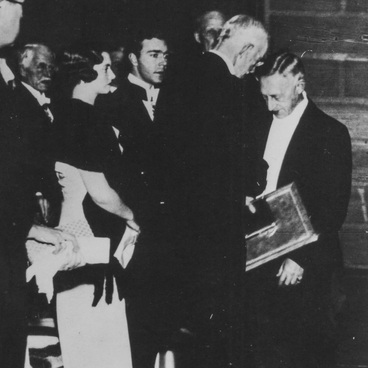In the old days, a secretary desk was a popular item of furniture. It was a small cabinet with drawers and shelves for storing important papers. The first secretary desk was made in 1730 as Kama furniture. Early secretary desks were made with a cabinet for papers and folding board for a writing table, and later such tables had a cover that covered the table top.
The exhibit of the museum presents a rectangular secretary desk made of birch wood with two drawers. The table was a part of the interior of Ivan Bunin’s Parisian apartment and occupied the right corner of the dining room in front of the entrance to the writer’s study-bedroom. Vera Muromtseva, the wife of the classic, kept securities, invoices and other important documents in its drawers.
In the centre of the top shelf of the secretary desk, as during the life of the Bunin’s family, there are photographs of Vera Nikolaevna and Ivan Alekseevich – three photographs in one frame. And in the large photo on the left, Muromtseva is captured as a high-school student: she is dressed in a uniform dress with a white lace collar and cuffs.
Under the glass of the secretary desk, there are genuine letters from Muromtseva, which she sent to her brother Dmitry in Moscow. So, Vera Nikolaevna wrote to him about Paris: “We rented an unfurnished flat and bought furniture at an auction, cheap…” The contemporaries recalled that Muromtseva-Bunina was very fond of writing letters and always approached the correspondence thoroughly.
The Bunins moved from Russia to Paris in 1920. The writer strenuously refused to accept the revolutionary events of 1917 and the new government. So, in February of 1924, Bunin, together with Dmitry Merezhkovsky, Ivan Shmelev and other domestic workers of arts and science, took part in an event called “Mission of the Russian emigration”. Ivan Alekseevich made a presentation and insisted that the task of the Russian emigration was to reject “Lenin”s commandments”. Some of those present engaged in a controversy against the writer, believing that those who did not acknowledge the revolution “wanted the rivers to flow backwards”. To which Bunin replied: “No, not like that, we do not want the backward, we want a different stream… Russia! Who dares to teach me how to love it? ”.



